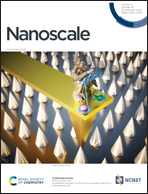A controlling parameter of topological defects in two-dimensional covalent organic frameworks†
Abstract
Synthesis of covalent organic frameworks with long-range molecular ordering is an outstanding challenge due to the fact that defects against predesigned topological symmetries are prone to form and break crystallization. The physical origins and controlling parameters of topological defects remain scarcely understood. By virtue of molecular dynamics simulations, we found that pentagons for combination [C4 + C4] and [C4 + C2] and heptagons for [C3 + C3] and [C3 + C2] were initial defects for growth dynamics with both uncontrolled and suppressed nucleation, further inducing more complex defects. The defects can be significantly reduced by achieving the growth with monomers added to a single nucleus, agreeing well with previous simulations and experiments. To understand the nature of defects, we proposed a parameter φ to describe the range of biased rotational angle between two monomers, within which chemical reactions are allowed. The parameter φ shows a monotonic relationship with defect population, which is demonstrated to be highly computable by using density functional theory calculations. When φ < 20, we can even observe defect-free growth for the four combinations, irrespective of growth dynamics. The results are essential for screening and designing condensation reactions for the synthesis of single crystals of high quality.



 Please wait while we load your content...
Please wait while we load your content...